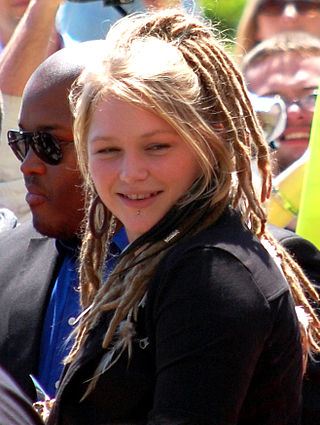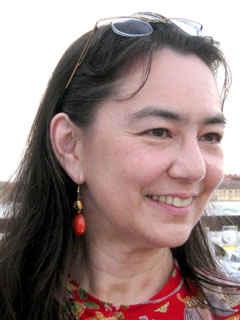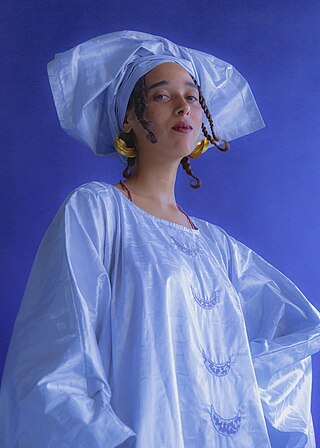Related Research Articles
Cyberfeminism is a feminist approach which foregrounds the relationship between cyberspace, the Internet, and technology. It can be used to refer to a philosophy, methodology or community. The term was coined in the early 1990s to describe the work of feminists interested in theorizing, critiquing, exploring and re-making the Internet, cyberspace and new-media technologies in general. The foundational catalyst for the formation of cyberfeminist thought is attributed to Donna Haraway's "A Cyborg Manifesto", third wave feminism, post-structuralist feminism, riot grrrl culture and the feminist critique of the alleged erasure of women within discussions of technology.

Hasan M. Elahi is a Bangladeshi-born American interdisciplinary media artist whose work has an emphasis on technology and media and their social implications. His research interests include issues of surveillance, sousveillance, simulated time, transport systems, and borders and frontiers.

Cornelia Sollfrank is a German digital artist, she was an early pioneer of Net Art and Cyberfeminism in the 1990s.

Internet art is a form of new media art distributed via the Internet. This form of art circumvents the traditional dominance of the physical gallery and museum system. In many cases, the viewer is drawn into some kind of interaction with the work of art. Artists working in this manner are sometimes referred to as net artists.

Crystal Lynn Bowersox is an American singer, songwriter and actress who was the runner-up on the ninth season of American Idol. She was the first female finalist in three years.

Petra Cortright is an American artist working in video, painting, and digital media.
Akiko Ichikawa is a transdisciplinary artist, editor, and writer-activist based in New York City. She has written on contemporary art and culture for Flash Art,Art in America, Hyperallergic, and zingmagazine. Ichikawa's article on the photography of Dorothea Lange, Toyo Miyatake, and Ansel Adams at Manzanar became popular in fall 2016, following comments by a spokesperson of a Trump-supporting PAC on Fox News.

Joanne McNeil is an American writer, editor, and art critic known for her personal essays on technology. She has written a book on internet culture.

Tamiko Thiel is an American artist, known for her digital art. Her work often explores "the interplay of place, space, the body and cultural identity," and uses augmented reality (AR) as her platform. Thiel is based in Munich, Germany.

Jessica Rose Meuse, also known as Jess Meuse, is an American singer-songwriter from Slapout, Alabama. After spending several years as an unsigned musician, she finished in fourth place on the thirteenth season of American Idol. Her debut album, What's So Hard About Bein' a Man, was self-released in 2011, three years before she gained national exposure on reality television. While competing on American Idol, she became the first person in the history of the series to perform an original song during the finals. Her second album, Halfhearted, was released on August 3, 2018, through Warrior Records.
Angela Washko is an American new media artist and facilitator based in New York. She is currently Associate Professor of Art at Carnegie Mellon University. Washko mobilizes communities and creates new forums for discussions of feminism where they do not exist.

Post-Internet is a 21st-century art movement involving works that are derived from the Internet or its effects on aesthetics, culture and society.
Anne-Marie Schleiner is a theorist, an educator, a new media and performance artist, a hacktivist, a scholar, a gamer, and a curator. Her work is focused on gender construction, ludic activism, situationist theory, political power struggles, experimental gaming design theory, urban play, the United States Military, avatar gender reification, the global south, and feminist film theory.
Ann Hirsch is a contemporary American video and performance artist. Her work addresses women's sexual self-expression and identity online and in popular culture.

Kristin Lucas is a media artist who works in video, performance, installation and on the Internet. Her work explores the impacts of technology on humanity, blurring the boundary between the technological and corporeal. In her work she frequently casts herself as the protagonist in videos and performances where her interactions with technology lead to isolation, and physical and mental contamination.

Marisa Morán Jahn, also known as Marisa Jahn is an American multimedia artist, writer, and educator based in New York City. She is a co-founder and president of Studio REV-, a nonprofit arts organization that creates public art and creative media to impact the lives of low-wage workers, immigrants, youth, and women. She teaches at Massachusetts Institute of Technology (MIT) as a lecturer, Teachers College of Columbia University, and The New School. Jahn has edited three books about art and politics.
Émilie Gervais is a Canadian new media artist based in Paris, France. Her work explores the relationships between internet, network culture, art and its mediation. In the past, she has described herself as, "a starry background artist working with the internet, deleting and restoring stuff, interacting with stuff and people".

Tabita Rezaire is a French new media artist of Guyanese and Danish descent, "health-tech-political" therapist, and "kemetic" and kundalini yoga teacher. She has presented her work at the Goodman Gallery in Johannesburg, Arebyte Gallery, London, the Athens Bienniale, MAXXI, Rome, and Artspace, Sydney. Her book is Conscience u.terre.ine. (2022)
RaFia Santana is a non-binary American artist, musician, and performer based in Brooklyn, NY. Her work ranges from animated gifs to self-portraiture, videos, and performance to editioned clothing and electronic music exploring gentrification, the millennial mindset, mental health, and the lived black experience. They use the internet as a medium to share their artwork, empower black and brown communities, and challenge ideas of solidarity and alliance. She had exhibitions and/or performances at the Eyebeam, AdVerse Fest, SleepCenter, Times Square Arts, International Center of Photography, Schomburg Center for Research in Black Culture, Babycastles, Museum of the Moving Image and Museum of Contemporary African Disaporan Arts, Roots & Culture amongst many notable venues. Her work has been featured in publications such as Huffington Post, HyperAllergic, Rhizome, ArtFCity, Vogue, Teen Vogue and Salon. She has participated in panels, performances and discussions such as Cultured Magazine, "Late at Tate Britain", Creative Tech Week NYC, Afrotectopia at Google NYC, NYU, "Black Portraitures IV: The Color of Silence" at Harvard University and International Center for Photography. Their music is released through Never Normal Records.

Nekane Aramburu Gil is a Spanish art historian with an extensive international career, who has worked as a cultural manager, museologist and curator since the 1990s. She was selected by competition as director of the Es Baluard museum in February 2013, following the recommendations of the Code of Good Practice in Museums and Art Centers in Spain, a position she held for six years. Since that date Es Baluard has been an organic and dynamic museum; its collections, activities and educational models were rearranged giving rise to an active cultural complex.
References
- ↑ "Rising stars No. 3: Marisa Olson - Christie's". Christies.com. Retrieved 28 June 2018.
- ↑ Napoli, Lisa (2004-09-23). "An 'American Idol' Hopeful's Blog". The New York Times . Retrieved 28 June 2018.
- ↑ "Rhizome - Nasty Nets". Classic.rhizome.org. Retrieved 28 June 2018.
- ↑ NET ART ANTHOLOGY: Marisa's American Idol Audition Training Blog. Rhizome. 2016. Retrieved 14 March 2019.
- ↑ "Marisa Olson - Creative Time Reports". Creative Time Reports. Retrieved 28 June 2018.
- ↑ NET ART ANTHOLOGY: Marisa's American Idol Audition Training Blog. Rhizome. 2016. Retrieved 14 March 2019.
- ↑ Vierkant, Artie (2010). "The Image Object Post-Internet" (PDF). netartnet. Retrieved March 9, 2019.
- ↑ Respini, Eva (2018). Art in the age of the Internet : 1989 to today. Boston, Massachusetts: Yale University Press. p. 15. ISBN 9780300228250.
- ↑ McHugh, Gene (2014). Post Internet (in Italian). Lulu Press, Inc. ISBN 9781291858402 . Retrieved 13 March 2019.
- ↑ Metz, Nina. "Art + defunct technology = cultural critique". chicagotribune.com. Retrieved 13 March 2019.
- ↑ Steinberg, Monica (2019). "(Im)Personal Matters: Intimate Strangers and Affective Market Economies". Oxford Art Journal. 42: 45–67. doi:10.1093/oxartj/kcy026 . Retrieved 13 March 2019.
- ↑ Metz, Nina. "Art + defunct technology = cultural critique". chicagotribune.com. Retrieved 13 March 2019.
- ↑ McHugh, Gene (2014). Post Internet (in Italian). Lulu Press, Inc. ISBN 9781291858402 . Retrieved 13 March 2019.
- ↑ Metz, Nina. "Art + defunct technology = cultural critique". chicagotribune.com. Retrieved 13 March 2019.